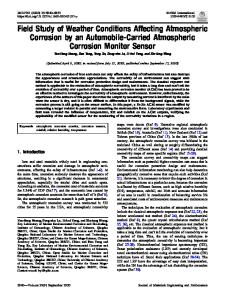Estimation of atmospheric corrosion of high-strength, low-alloy steels
- PDF / 186,308 Bytes
- 3 Pages / 612 x 792 pts (letter) Page_size
- 4 Downloads / 365 Views
S. VAYNMAN, Research Associate Professor, R.S. GUICO, Student, and M.E. FINE, Professor, are with the Department of Materials Science and Engineering, Northwestern University, Evanston, IL 60201. S.J. MANGANELLO is an Independent Consultant, 143 Castle Drive, Pittsburgh, PA, 15235. Manuscript submitted January 2, 1997. 1274—VOLUME 28A, MAY 1997
Table I.
Element Limits for Steels from ASTM G101 Concentration (Wt Pct)
Element
Lower Limit
Upper Limit
Cu Ni Cr Si P
0.008 0.05 0.10 0.10 0.01
0.49 1.10 1.30 0.64 0.12
(a)
(b) Fig. 1—Effect of copper concentration on atmospheric corrosion of (a) Bessemer steel in marine environment (Kure Beach, NC)[4] and (b) steels from the Larrabee and Coburn data set[3] in different environments.
Table II.
Element Limits in LaQue Database[5] (23 Steels) Concentration (Wt Pct)
Element
Lower Limit
Upper Limit
C Mn Si S P Ni Cu Cr Mo
0.020 0.020 0.002 0.010 0.005 0.004 0.030 0.000 0.000
0.190 0.890 1.000 0.050 0.140 4.990 1.090 1.190 0.240
and Coburn database[3] for 270 steels and LaQue database[3] for 23 steels) were used. The limits for element concentrations for these databases are presented in Tables I and II. The following equations were developed to fit the corrosion loss data using least-squares analysis assuming a separate power-law relationship for each element. For steels from the Larrabee and Coburn[3] database: METALLURGICAL AND MATERIALS TRANSACTIONS A
Fig. 2—Plot of atmospheric corrosion thickness losses for 270 steels from the Larrabee and Coburn data set at Kure Beach, NC vs the corrosion index from Eq. [1] (corrosion resistance index as a sum of the element concentrations with their respective coefficients). The line represents Eq. [1].
Fig. 5—Plot of atmospheric corrosion thickness losses of 23 steels from the LaQue data set at Kure Beach, NC vs the corrosion index from Eq. [1]. The line represents Eq. [1].
Fig. 3—Plot of atmospheric corrosion thickness losses for 270 steels from the Larrabee and Coburn data set at Kure Beach, NC vs the Legault– Leckie corrosion index from Eq. [3]. The line represents Eq. [3].
Fig. 6—Experimental corrosion losses for 23 steels from the LaQue database vs calculated corrosion losses using the Legault–Leckie equation, Eq. [3].
Loss of thickness (mm) in 15.5 years 5 25.4 (15.49 2 16.30Cu 2 4.34Ni 2 4.79Cr 2 12.41Si 2 32.01P
[3]
1 2.93CuNi 1 2.46CuCr 1 4.36CuSi 1 2.74NiSi 1 12.82NiP 1 1.75SiP 1 16.60Cu2 1 1.20Cr2 1 4.25Si2)
Fig. 4—Plot of atmospheric corrosion thickness losses of 23 steels from the LaQue data set at Kure Beach, NC vs the corrosion index from Eq. [2]. The line represents Eq. [2].
Loss of thickness (mm) in 15.5 years 5 144.73 (1.31Cu 1 0.47Ni 1 0.36Cr 1 0.99Si 1 1.33P)20.5552
[1]
For steels from the LaQue[5] database: Loss of thickness (mm) in 15.5 years 5 885.16 (248.3C 1 10.0Mn 1 28.5Si 1 61.1S 1 52.4P 1 7.5Ni 1 4.3Cu 1 5.6Cr 1 16.2Mo)20.644
[2]
The Legault–Leckie equation[2] for a marine environment (Kure Beach, NC) established using the Larrabee and Coburn[3] database, but eliminating the ten
Data Loading...











